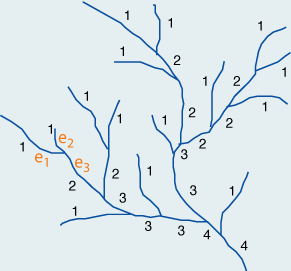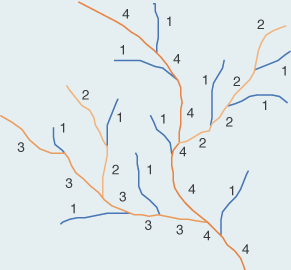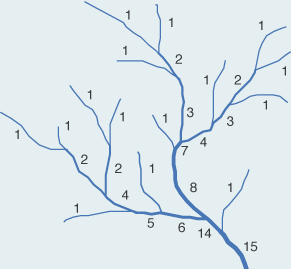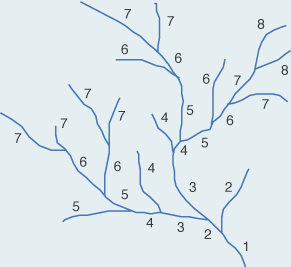|
|
Hierarchies in trees
In quantitative geomorphology, more specificall in the field of fluvial morphology, different methods for structuring and order of hierarchical stream networks have been developed. Thus, different networks can be compared with each other (e.g. due to the highest occurence order or the relative frequencies of the unique levels), and sub-catchments can be segregated easily. Of the four ordering schemes in the following figure, only three are topologically defined. The Horton scheme is the only one that takes the metric component into account as well.
 Strahler stream order Strahler stream order |
Calculating the strahler number, we start with the outermost branches of the tree. The ordering value of 1 is assigned to those segments of the stream. When two streams with the same order come together, they form a stream with their order value plus one. Otherwise, the higher order of the two streams is used. The strahler number is formally defined as:  where e1 and e2 are the joining stream segments and e3 is the evolving stream. Associated with the Strahler numbers of a tree are bifurcation ratios, numbers describing how close to balanced a tree is:  where Ns1 is the number of edges of a specific order (e.g. Order 1) and Ns2 is the number of edges of the next higher order. In the example on the left, Ns1 = 15 and Ns2 = 7. This results in the bifurcation ration of:  |
 Horton stream order Horton stream order |
First, an order according to Strahler is calculated. Then, the highest current order larger than 2 is assigned to the longest (metric) branch in the remaining sub-trees. |
 Shreve stream order Shreve stream order |
The Shreve stream order (also called magnitude) of a sub-tree indicates how many segments of first order (or "sources") are upstream. One possible application outside hydrology or geomorphology is in the choice of line widths in the cartographic representation of river networks. |
 Order by path length Order by path length |
A simple order by path length is achieved by identifying the length of the paths by starting at the tree's root. |
